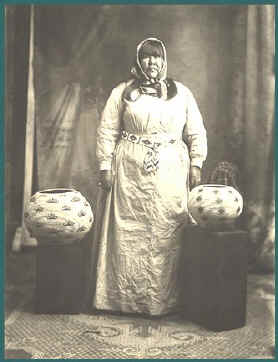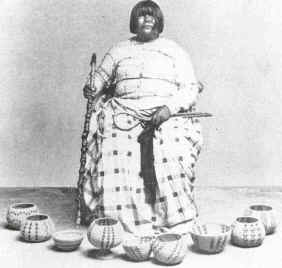|

|
CaliforniaBaskets |

|
Dat So La Lee [Louisa
Keyser]
|

Photo Credit NV Historical Society Reno
|

Dat So La Lee
"American Indian Basketry No. 12"
"Washoe Basketry"
written by Marvin
Cohodas Ph.D.
Published by John M. Gogol
Available
Here!
|
Author: Rachelle Larson
Datsolalee was a very talented basket weaver. In her lifetime she made over 250
baskets. Many of these baskets are in museums all over the country. The pattern of each
basket had to be planned very carefully. For even if one strip was out of place the
pattern would be ruined. But Datsolalee's baskets were done with perfection and
outstanding workmanship. This was miraculous considering that she was almost blind.
Datsolalee's real name is Louisa Keyser. Her Washoe Indian tribe in Nevada gave her the
name Datsolalee which means "The Queen Of Washoe Indian Basketmakers." They gave
her this name because they were very proud of her work and accomplishments.
Fame and recognition were two things that Datsolalee achieved in her lifetime. She was
recognized by her Indian tribe and those societies that were non-native as well. Her
pieces were very well made and highly prized as collectors items.
But this success was not easily or swiftly achieved. Datsolalee lived in a time when
her tribe was losing everything they valued. They were being forced from their land, they
were losing their power, and they felt hopeless standing against the government. Yet even
in hard times Datsolalee remained optimistic. She was very proud of her craft and she did
all she could to use it to her benefit.
During these hard times, Datsolalee worked as a maid and created baskets in her spare
time. She worked for Amy and Abraham Cohn. They were the owners of The Cohn Emporium;
which was a men's clothing store. Amy was fascinated by Indian culture, especially
basketry. Under Amy's direction, the Cohn's obtained a large collection of Washoe baskets;
as well as works from other tribes. Then, they sold these works to interested buyers. When
they discovered there was money to be made they brought up all the available pieces and
commissioned weavers to make more basket to sell.
Louisa was one of these weavers. She was encouraged to devote as much time and effort
as possible into basket weaving. The Cohns were so impressed with her work that they
offered her full patronage in return for the ownership of her baskets. Louisa and her
husband, Charlie Keyser, were supported for more that 25 years by the Cohns.
Traditional, was not a word that anyone would use to describe Louisa's baskets. She
single-handily changed the art of Washoe basket weaving. She changed and refined the
stitching technique to create a new shape of basket called, degikup. Degikup was a larger
basket which curved in towards the top. She also expanded the design to cover most of the
basket surface. Then, she introduced a dye called, Redbud. This was used along with a
black dye for decoration. Louisa was also influential in establishing the direction for
the new curio style and the three coil method as well.
Her baskets were continually evolving into many forms and designs. Some say that these
changes were made mainly to increase sales. Others say that her work can be describe as,
"art for art's sake." However, many weavers imitated her work and through her
innovations she changed the art of Washoe basket weaving forever.
References:
Davis, A.P. and Selvidge M. J. (1995). Focus on Women. Huntington Beach, CA:
Teacher Created Materials, Inc.
Porter, F.W. (1990). The Art Of Native American Basketry. Westport, CN:
Greenwood Press.
Turnbaugh, S.P. and Turnbaugh, W.A. (1986). Indian Baskets. West Chester, PN:
Schiffer Publishing.
Links To Sites With More Info On Dat
So La Lee:
Dat
So La Lee at a Glance
Dat
So La Lee at the Emporium Co.
Recoveries
of Washoe Indian Baskets Dat
So La Lee By: Carol Van Etten
The
Art of Native American Basketmaking By Tanya Branson
Dat
So La Lee and the Washoe Basket Weavers
See Marvin
Cohodas's Book:
"Degikup"
for more info on these Weavers
WASHOE
BASKET
Attributed to Dat
So La Lee
Nevada State Museum
Virtual Anthropology Gallery
Or:
E-mail us at
sales@californiabaskets.com
for a free info packet on Dat So La Lee |